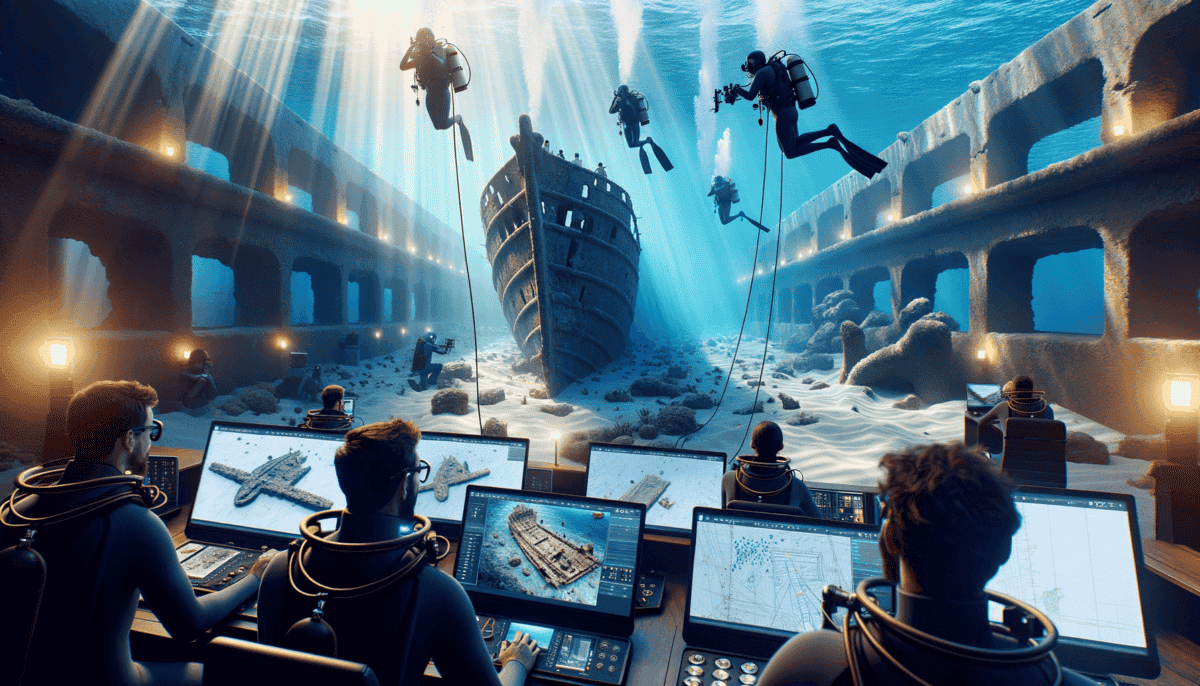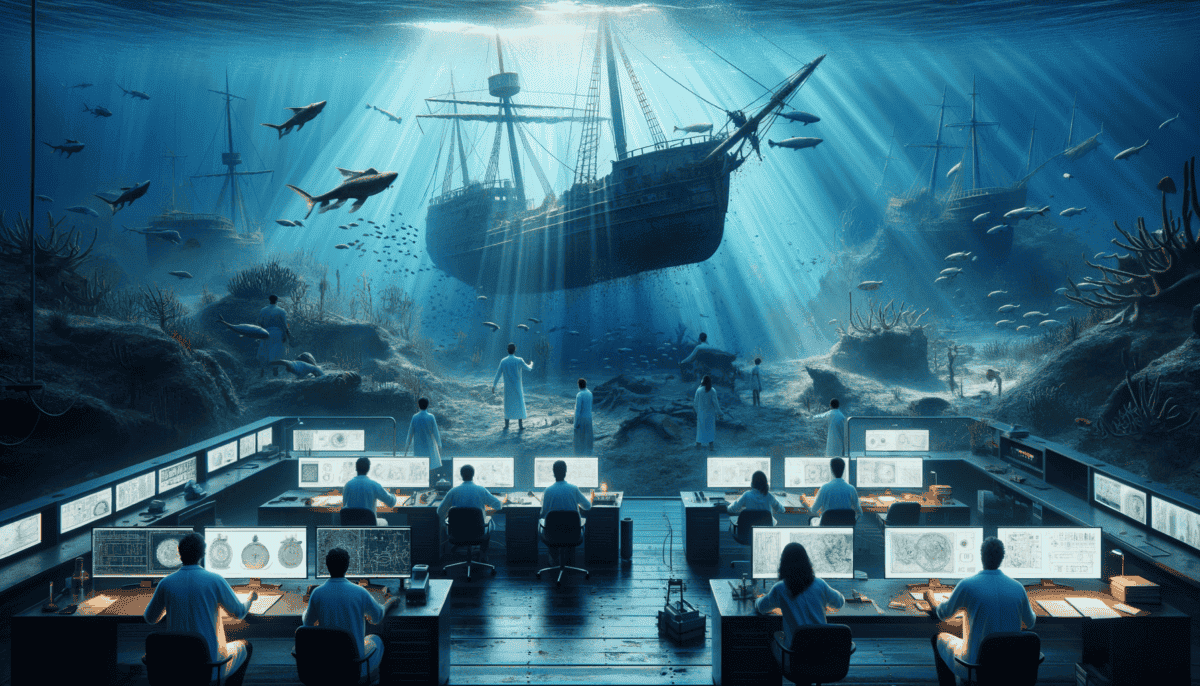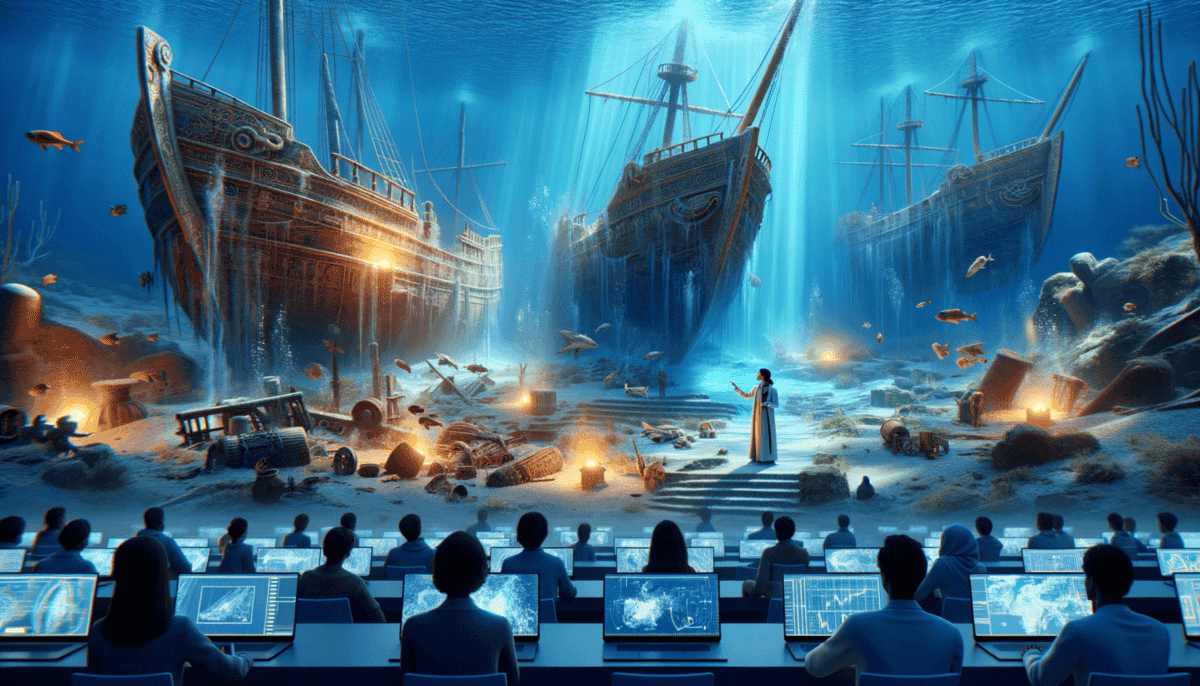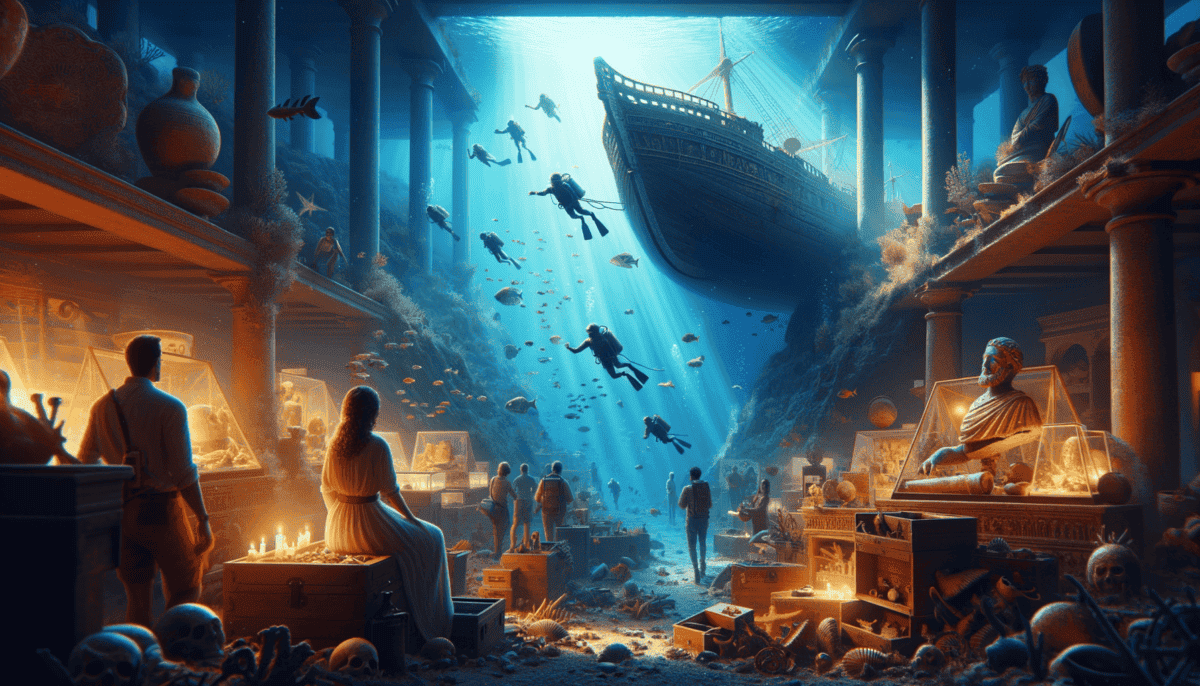The Underwater Discovery
The bright morning sun sparkled on the Mediterranean Sea as Dr. Elena Rodriguez peered over the edge of her research boat. Her dark curls danced in the salty breeze while she adjusted her lucky red bandana.
"Today feels different," Elena said to her team. "The water is so clear!"
Marco, her diving partner, nodded excitedly. "Perfect conditions to find something amazing!"
The small research boat gently rocked as Elena checked their position on the map. They were exploring a special area where old stories said Roman ships had sunk long ago. Ancient Rome was a mighty empire that ruled these waters over 2,000 years ago.
Elena carefully lowered their underwater robot named "Scout" into the crystal-clear water. Scout had bright lights and special cameras to see deep under the waves. On the boat's screen, Elena and her team watched as Scout zoomed through the blue water.
"Look!" Marco pointed at something dark appearing on their screen. "Those shapes look man-made!"
Elena's heart beat faster as she steered Scout closer. Through the murky distance, they could see long wooden beams lying on the seafloor. They were arranged in a way that could only mean one thing – a shipwreck!
“This is incredible,” Elena whispered. “We might have just found an ancient Roman ship!”
The team huddled around the screen as Scout's lights revealed more exciting clues. There were broken pieces of pottery scattered around the wooden beams. Some still had beautiful red and black patterns painted on them!
But the most amazing discovery came when Scout's camera peeked inside a dark opening in the wreck. Something shiny caught the light – a small bronze statue of a woman wearing flowing robes.
"That's a Roman goddess!" Elena exclaimed. "This has to be from an important Roman ship!"
The team worked quickly to mark the exact spot on their maps. They would need to come back with more equipment to study their amazing find. But Elena knew this was just the beginning of a wonderful adventure.
As the sun began to set, painting the sky in beautiful oranges and pinks, Elena couldn't stop smiling. After years of searching, they had finally found what might be one of Ancient Rome's lost ships!
Marco patted her shoulder as they headed back to shore. "What do you think we'll find next time?"
"I don't know," Elena replied, her eyes sparkling with excitement. "But I can't wait to find out!"
• Wooden ship remains
• Ancient pottery pieces
• Bronze statue of Roman goddess
That night, Elena wrote in her research journal about their amazing day. Tomorrow they would start planning their next visit to the shipwreck. What other secrets would they find hidden beneath the waves? Only time would tell!
Tracing Maritime Legends
The next morning, Elena sat in her cozy office at the museum. She spread out old maps on her desk while sipping hot chocolate.
“These ancient Roman ships were so amazing,” she told her friend Sarah, who worked in the museum library. “They could sail across the whole Mediterranean Sea!”
Sarah pulled out a dusty book with pictures of old Roman coins. “Look at this,” she said, pointing to a coin with a ship on it. “The Romans put pictures of their ships on their money!”
Elena looked closer at the coin. The ship looked just like the wooden pieces they found underwater! Her eyes got wide with excitement.
“This means our shipwreck might be from a very special fleet of ships,” Elena said. “They carried treasures from far away places to Rome!”
“The Romans were like the truck drivers of the ancient world,” Sarah laughed. “But they used boats instead of trucks!”
Elena and Sarah spent hours looking at old maps. They found the routes Roman ships used to take:
• From Egypt with grain
• From Spain with silver
• From Greece with olive oil
• From Syria with spices
“Our shipwreck is right here,” Elena said, marking an X on the map. “It was probably sailing from Egypt to Rome when something went wrong.”
Just then, Marco rushed into the office waving a paper. “Elena! The lab results came back from the pottery pieces!”
“What do they say?” Elena and Sarah asked together.
“The clay is from Egypt! And they’re about 2,000 years old!” Marco’s eyes sparkled with excitement.
“I knew it!” Elena jumped up from her chair. “This proves our ship was carrying goods from Egypt to Rome!”
But there were still puzzles to solve. Why did the ship sink? What else was it carrying? Elena wrote down their questions in her special notebook.
“Tomorrow we’ll use our special underwater robots again,” she told Sarah. “We’ll take better pictures of everything we find!”
That evening, Elena stayed late at the museum. She carefully studied the coin with the ship picture. Something caught her eye – a tiny symbol near the ship’s bow.
“Sarah!” she called out. “Come look at this symbol! It matches the one on our bronze statue!”
The two friends looked at each other with huge smiles. They were getting closer to solving the mystery of their ancient Roman shipwreck.
As Elena packed up her things, she couldn’t help but wonder what other clues they would find tomorrow. The lost ships of Ancient Rome were slowly sharing their secrets, one discovery at a time.
Technology Meets History
The morning sun sparkled on the waves as Elena and her team loaded their special underwater robots onto the boat.
“Today’s the big day!” Elena said, checking all the equipment. “Our new sonar will show us the whole shipwreck!”
Marco turned on the robot’s camera screens. “Look how clear the picture is today!” he said excitedly. The water was super clear, like looking through glass.
The team lowered their first robot, nicknamed “Scout,” into the water. Scout had bright lights and cameras to see in the dark ocean.
“Scout is sending pictures!” Sarah called out. Everyone gathered around the screens.
The wooden ship was bigger than they thought! It was as long as their research boat. Scout’s lights showed rows of old clay jars still lined up neatly.
“It’s like finding a grocery store that’s been underwater for 2,000 years!” Marco laughed.
But then something went wrong. Scout’s propeller got tangled in some old fishing nets!
“Oh no!” Elena worried. “We need Scout to map the whole shipwreck!”
Quick thinking saved the day. They sent their backup robot, “Helper,” to cut Scout free. The whole team cheered when Scout started moving again.
The robots worked together to make a special 3D map of the shipwreck. It looked like a video game version of the ancient ship!
• Rows of clay jars still sealed shut
• Beautiful bronze statues
• Wooden boxes with mystery items
• Ship’s steering wheel still in place
• Ancient tools the sailors used
“Elena! Come quick!” Sarah shouted. “The robot found something amazing in the front of the ship!”
Everyone crowded around the screen. There, perfectly preserved in the mud, was a wooden chest with metal decorations.
“Could this be the captain’s special box?” Elena wondered. “It might tell us who was on this ship!”
The sun was setting when they finally brought the robots back up. They had taken hundreds of pictures and made detailed maps of every part of the ship.
“Tomorrow we can start bringing up some of the things we found,” Elena told her tired but happy team. “This is going to help us learn so much about ancient Roman ships!”
That night, Elena couldn’t sleep. She kept thinking about the mysterious chest. What secrets would it reveal about the brave sailors who sailed this ship so long ago?
The ancient Romans were amazing builders and sailors. Now, with help from modern robots and computers, their lost ships were sharing stories from the past.
The Lost Ship’s Treasures
The sun was barely up when Elena and her team started lifting treasures from the ancient ship.
“Ready the crane!” Elena called out. They had to be super careful with each old item they brought up.
The first items came up in special nets. There were clay jars called amphoras. Some still had olive oil inside from 2,000 years ago!
“Look at this!” Marco held up a small bronze mirror. “Someone used this to check their hair way back then!”
Sarah worked in the special lab on the boat. She cleaned each item very gently with soft brushes. “These things are like messages from the past,” she said.
“Each piece tells us a story about the people who were on this ship,” Elena agreed.
Then came the exciting moment – lifting up the captain’s chest! The team held their breath as the crane slowly raised it from the water.
The wooden chest was heavy and covered in pretty metal designs. But when they tried to open it, it was stuck!
• Gold coins with pictures of Roman kings
• A special ring with a red stone
• Maps drawn on animal skin
• Letters written in Latin
• Small statues of Roman gods
“These coins tell us the ship sailed during Emperor Hadrian’s time!” Elena explained. “That’s around 120 AD!”
But not everyone agreed about what the things meant. Marco thought the ship was a trading boat, but Sarah believed it was a navy ship.
“See these weapons?” Sarah pointed to some rusty spears. “Trading ships didn’t carry so many!”
The most special find was a small clay plate. Someone had scratched their name on it – “Marcus Flavius.”
“This belonged to a real Roman sailor!” Elena said excitedly. “Now we know at least one person who was on this ship!”
Each item they found was like a piece of a big puzzle. Together, they showed how Romans lived on their ships.
The team found games the sailors played, cooking pots they used, and even a lucky charm shaped like a dolphin!
At sunset, Elena looked at all the treasures they’d brought up. “Tomorrow we’ll learn even more about our Roman friends,” she smiled.
That night, she dreamed about Marcus Flavius and his friends sailing across the big blue sea, never knowing that someday their lost ship would be found.
Connecting Ancient Dots
Elena sat in her cozy office, surrounded by pictures of the ship treasures. A big world map covered one wall. She was putting red pins where other Roman ships had been found. ️
“This is amazing!” she said to Sarah. “Our ship matches the path of Emperor Hadrian’s navy!”
Dr. Paolo from Italy walked in, holding an old book. “Elena, look what I found in Rome’s records!” His eyes were bright with excitement.
“There’s a story about a missing ship from Hadrian’s fleet. It carried special gifts for Egypt’s leaders!”
Sarah jumped up from her chair. “That explains the fancy gold boxes we found!”
But not everyone was happy about their work. Dr. Thompson from another team showed up uninvited.
“You’re doing everything wrong,” he said grumpily. “Those aren’t Hadrian’s ships at all!”
Elena stayed calm. “Let’s look at the proof together,” she said nicely.
“Science is about working together, not fighting,” she reminded everyone.
• The ship was part of a special navy group
• It carried gifts from the emperor
• It sailed from Rome to Egypt
• It got lost in a big storm
• It had 30 sailors on board
Elena’s phone rang. It was the Rome Museum! “We want to show your findings in a big display,” they said. ️
“Wonderful news!” Elena told her team. “But first, we have more secrets to uncover.”
They studied the old maps from the captain’s chest. Marcus Flavius had drawn tiny pictures of sea monsters in the corners!
“Even brave Roman sailors believed in sea creatures,” Sarah laughed.
The team made an amazing discovery about Roman ships. “Look at these special wooden pieces,” Elena pointed. “They helped ships sail faster than we thought possible!”
Dr. Paolo nodded. “This changes everything we knew about Roman navy power!”
As the sun set, Elena looked at Marcus Flavius’s name plate again. “We’re telling your story,” she whispered. “After 2,000 years, the world will know about your brave journey.” ⛵
That evening, news reporters came to film their work. “Ancient Rome’s lost ships are teaching us new things about history,” Elena told them proudly.
Back in her office, Elena wrote in her diary: “Today we solved big mysteries about Rome’s ships. But tomorrow might bring even bigger surprises!”
Treasure for the World
The morning sun sparkled on the museum’s glass cases. Elena smiled as she watched workers carefully place the ancient treasures inside.
“Perfect!” she said, adjusting a golden cup from the shipwreck. “Every piece tells a story.”
Sarah ran in, waving a piece of paper. “Elena! The scientists finished studying the ship’s wood. It’s exactly 1,889 years old!”
“That means the ship sank in 134 AD,” Elena said. “Right when Emperor Hadrian was ruling Rome!”
Dr. Paolo brought in a special gift. It was a model of how the ship looked when it was new.
“Now everyone can see how beautiful Roman ships were,” he said proudly.
The team gathered around their favorite finds in the display:
• The captain’s golden name plate
• Pretty dishes with pictures of gods
• Jewelry for Egyptian leaders
• Maps with sea monster drawings
• Coins with Emperor Hadrian’s face
A small girl pressed her nose against the glass. “Were there really sea monsters?” she asked Elena.
“The Romans thought so!” Elena laughed. “They were brave to sail such big ships.”
Dr. Thompson, who had been mean before, came to see the display. “I was wrong,” he said nicely. “You did amazing work.”
Elena shook his hand. “Thank you. Science is better when we work together.”
The museum director hung a big sign: “Rome’s Lost Ships – Found After 2,000 Years!” ⚓
People from all over the world came to see the treasures. They took pictures and said “Wow!” a lot.
Elena taught school groups about the ships. “The Romans were great builders,” she explained. “Their ships could sail very far.”
One day, a letter arrived from Italy’s president. “You have helped us understand our history better,” it said.
“What’s next?” Sarah asked, as they watched happy families explore the museum.
Elena’s eyes sparkled. “The ocean is full of lost ships. Each one has a story to tell!”
She touched the captain’s name plate one last time. Thanks to their hard work, Marcus Flavius’s brave journey would never be forgotten.
That night, Elena wrote in her diary: “Finding lost ships isn’t just about old stuff. It’s about connecting with brave people from long ago. And there are many more adventures waiting under the waves!”






